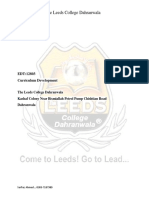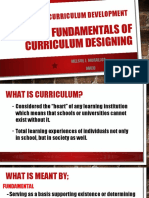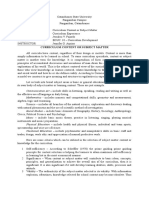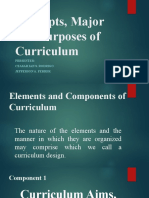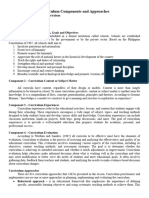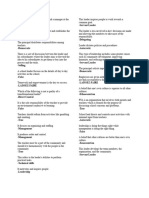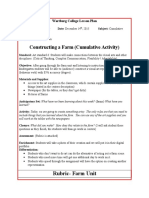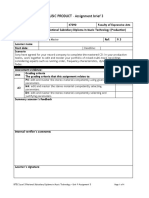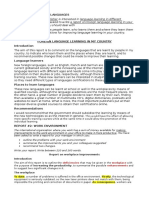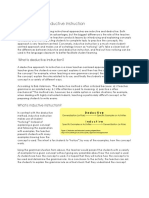0 ratings0% found this document useful (0 votes)
34 viewsCurriculum Exp
Curriculum Exp
Uploaded by
Kim Nicole VargasThe document discusses different perspectives on curriculum from traditional and progressive views. From a traditional standpoint, curriculum is a standardized set of subjects and content taught in a structured manner. Progressively, curriculum is seen as more dynamic and student-centered, integrating real-life experiences beyond textbooks through hands-on learning and problem-solving. Overall, the document contrasts traditional and progressive philosophies on curriculum and their approaches to content, teaching methods, and the role of the teacher versus student.
Copyright:
© All Rights Reserved
Available Formats
Download as PDF, TXT or read online from Scribd
Curriculum Exp
Curriculum Exp
Uploaded by
Kim Nicole Vargas0 ratings0% found this document useful (0 votes)
34 views3 pagesThe document discusses different perspectives on curriculum from traditional and progressive views. From a traditional standpoint, curriculum is a standardized set of subjects and content taught in a structured manner. Progressively, curriculum is seen as more dynamic and student-centered, integrating real-life experiences beyond textbooks through hands-on learning and problem-solving. Overall, the document contrasts traditional and progressive philosophies on curriculum and their approaches to content, teaching methods, and the role of the teacher versus student.
Original Description:
Module 2 of The Teacher and the School Curriculum
Original Title
CURRICULUM EXP (1)
Copyright
© © All Rights Reserved
Available Formats
PDF, TXT or read online from Scribd
Share this document
Did you find this document useful?
Is this content inappropriate?
The document discusses different perspectives on curriculum from traditional and progressive views. From a traditional standpoint, curriculum is a standardized set of subjects and content taught in a structured manner. Progressively, curriculum is seen as more dynamic and student-centered, integrating real-life experiences beyond textbooks through hands-on learning and problem-solving. Overall, the document contrasts traditional and progressive philosophies on curriculum and their approaches to content, teaching methods, and the role of the teacher versus student.
Copyright:
© All Rights Reserved
Available Formats
Download as PDF, TXT or read online from Scribd
Download as pdf or txt
0 ratings0% found this document useful (0 votes)
34 views3 pagesCurriculum Exp
Curriculum Exp
Uploaded by
Kim Nicole VargasThe document discusses different perspectives on curriculum from traditional and progressive views. From a traditional standpoint, curriculum is a standardized set of subjects and content taught in a structured manner. Progressively, curriculum is seen as more dynamic and student-centered, integrating real-life experiences beyond textbooks through hands-on learning and problem-solving. Overall, the document contrasts traditional and progressive philosophies on curriculum and their approaches to content, teaching methods, and the role of the teacher versus student.
Copyright:
© All Rights Reserved
Available Formats
Download as PDF, TXT or read online from Scribd
Download as pdf or txt
You are on page 1of 3
It highlights that curriculum is a crucial aspect that impacts various stakeholders, including
teachers, students, parents, politicians, businessmen, professionals, government officials, and
the general public.
The understanding of curriculum extends beyond the confines of educational institutions and
involves various aspects of society. Recognizing the importance of curriculum is essential for all
stakeholders, as it shapes the educational experiences of individuals and has broader
implications for the development of human capital and society as a whole.
Some definition of curriculum
1. A curriculum is a carefully organized plan of learning activities and goals created by
schools to help students grow intellectually and socially. It outlines what students are
supposed to learn and achieve, guiding their educational journey for overall
development.
2. A curriculum is a written document that systematically outlines the planned goals,
objectives, content, learning activities, and evaluation procedures for a particular
educational program or course. It serves as a structured guide, providing a roadmap for
educators to follow in order to ensure a comprehensive and organized learning
experience for students. The document helps shape the overall direction and purpose of
the educational program, facilitating effective teaching and learning.
3. A curriculum is a comprehensive plan that includes the subjects, concepts, and tasks
students will learn. It outlines the planned activities, the expected learning outcomes,
and the experiences students will have. Additionally, it incorporates cultural elements
and has an agenda aimed at bringing about positive changes in society through
education. Essentially, a curriculum is a structured guide that shapes what students learn
and how they develop both academically and socially.
4. A curriculum encompasses all the experiences that individual learners go through in an
educational program designed to achieve broad goals and specific objectives. It is
carefully planned based on a framework of theory, research, and past and present
professional practices. In simpler terms, a curriculum is the overall plan for what students
will learn and experience during their education. It is structured to meet specific
educational goals and is informed by established theories, research findings, and the
best practices in the relevant field.
5. This statement is emphasizing that a curriculum is essentially a planned set of activities
carried out by both teachers and students with the goal of helping students achieve
specific educational objectives. The activities and lessons are organized in a way that
aims to guide students toward reaching these desired ends or goals in their learning. In
other words, a curriculum outlines the educational journey, detailing what students
should learn and the activities that will facilitate their understanding and attainment of
knowledge and skills.
6. The statement is describing a curriculum as a structured plan that provides learning
opportunities within a specific time frame and location. It serves as a tool designed to
induce behavioral changes in students through planned activities. The curriculum
encompasses all the learning experiences students receive under the guidance of the
school. In essence, it outlines what, when, and where students will learn, with the
ultimate goal of influencing their behavior and fostering comprehensive development.
7. This statement is highlighting that a curriculum serves to address three fundamental
questions:
What knowledge, skills, and values are most worthwhile?
● This question focuses on identifying the essential content and outcomes that
students should acquire through the educational process.
Why are they most worthwhile?
● This question delves into the justification or rationale behind selecting specific
knowledge, skills, and values, emphasizing their importance and relevance to the
students' overall development.
How should the young acquire them?
● This question pertains to the instructional methods and approaches that should
be employed to effectively impart the identified knowledge, skills, and values to
students. It considers the most effective means of learning and teaching.
In summary, a curriculum aims to provide thoughtful responses to these three questions, guiding
the educational process in terms of content selection, justification, and instructional strategies.
Curriculum from Traditional Point of View
- In a traditional educational philosophy, the curriculum is typically viewed as a structured
and standardized set of subjects, content, and activities that all students should learn.
The traditional perspective emphasizes a more teacher-centered approach and often
follows a prescribed sequence of subjects.
- The content of the curriculum is predetermined and standardized. There is often a set
body of knowledge that all students are expected to acquire, and this content is typically
outlined in textbooks or curriculum guides.
- Traditional education often places a strong emphasis on discipline and order in the
classroom. Students are expected to adhere to rules, follow instructions, and maintain a
structured learning environment.
- traditional perspective on curriculum tends to be more structured, teacher-centered, and
focused on the transmission of established knowledge. It often follows a linear
progression of subjects and content, with an emphasis on uniformity and standardization
in teaching and assessment.
Curriculum from Progressive Points of View
- In a progressive educational philosophy, the concept of curriculum is viewed in a more
dynamic and student-centered manner. Progressive educators advocate for an approach
that goes beyond a fixed set of subjects and emphasizes the importance of active,
experiential learning.
- Progressive educators believe in integrating real-life experiences into the curriculum.
Learning is not confined to textbooks but extends into the exploration of the surrounding
environment, hands-on activities, and problem-solving situations.
- progressive perspective on curriculum seeks to create a more engaging, relevant, and
student-centered educational experience that prepares individuals for active and
thoughtful participation in society.
You might also like
- Midterm Exam AnswersDocument4 pagesMidterm Exam AnswersMary Jean Empeng100% (1)
- Dimensions and Principles of Curriculum DesignDocument6 pagesDimensions and Principles of Curriculum DesignJo Nerak Bayudo Lupeba64% (14)
- VI. Pre-Test: Write Your Answer On The Provided Box. 1. Explain Why Rizal Works & Writings Is A Mandated Subject To Be Taught To All Schools inDocument2 pagesVI. Pre-Test: Write Your Answer On The Provided Box. 1. Explain Why Rizal Works & Writings Is A Mandated Subject To Be Taught To All Schools inlynel jim malicdemNo ratings yet
- Social Studies Grade 6 Strand A: Heritage and Identity: Communities in Canada, Past and PresentDocument53 pagesSocial Studies Grade 6 Strand A: Heritage and Identity: Communities in Canada, Past and Presentapi-282102354100% (2)
- Curriculum ExpDocument2 pagesCurriculum ExpKim Nicole VargasNo ratings yet
- Principles of Curriculum DevelopmentDocument10 pagesPrinciples of Curriculum DevelopmentShams AztabNo ratings yet
- Inbound 3721883230623988158Document8 pagesInbound 3721883230623988158alesnaqueenie430No ratings yet
- 8603 ass 1Document34 pages8603 ass 1Faisal RasheedNo ratings yet
- 90957school CurriculumTextbookDocument127 pages90957school CurriculumTextbookrehamraoufahmedNo ratings yet
- CURRICULUMDocument6 pagesCURRICULUMIhsanaNo ratings yet
- Curriculum Planning ReflectionDocument10 pagesCurriculum Planning ReflectionKim B. PorteriaNo ratings yet
- PED 9 Chapter 1Document13 pagesPED 9 Chapter 1QUIJANO, FLORI-AN P.No ratings yet
- Approaches To Curriculum Design 2Document47 pagesApproaches To Curriculum Design 2PreciousMaviSalemCarcosiaNo ratings yet
- Formulation of Philosophy, Objectives, Selection and Organization of Learning ExperienceDocument7 pagesFormulation of Philosophy, Objectives, Selection and Organization of Learning ExperienceMallika Joon100% (2)
- Curriculum - Module 1Document9 pagesCurriculum - Module 1Mariel Althea PeregrinNo ratings yet
- Educ 9 Midterm ReviewerDocument7 pagesEduc 9 Midterm ReviewerYuri YuriNo ratings yet
- Curriculumdevelopment 180728180957Document55 pagesCurriculumdevelopment 180728180957Beulah Dasari100% (1)
- The Teacher and School The Curriculum: Prepared byDocument8 pagesThe Teacher and School The Curriculum: Prepared byBES BEBENo ratings yet
- CurriculumDocument9 pagesCurriculumanamasih141993No ratings yet
- Supervision and Instruction - 072911Document45 pagesSupervision and Instruction - 072911Rowela AlongNo ratings yet
- Justol May Princess, Galve Maria AngelaDocument6 pagesJustol May Princess, Galve Maria AngelaMay Princess JustolNo ratings yet
- St103 Group 2 FinalDocument48 pagesSt103 Group 2 FinalJudyl Arciga CamoNo ratings yet
- Edt 21803Document55 pagesEdt 21803Nauman saleem50% (2)
- The Curriculum DimensionsDocument18 pagesThe Curriculum DimensionsKaye Anthonette Vedad83% (6)
- Files-Notes-Teacher & CurriculumDocument7 pagesFiles-Notes-Teacher & CurriculumFerliza Cudiamat PacionNo ratings yet
- MCC302 Curriculum Design in Physical EducationDocument27 pagesMCC302 Curriculum Design in Physical EducationrahulkshishodiaNo ratings yet
- Curriculum DevelopmentDocument21 pagesCurriculum Developmentglenn flor100% (1)
- Meaning of CurriculumDocument11 pagesMeaning of CurriculumFactoran WilfredNo ratings yet
- Curriculum DevelopmentDocument55 pagesCurriculum DevelopmentAnand gowda100% (1)
- Fundamentals of Curriculum Designing (Morallos)Document31 pagesFundamentals of Curriculum Designing (Morallos)MELSUE MORALLOS100% (2)
- Cus3701 Assignment 2Document5 pagesCus3701 Assignment 2Collen BezuidenhoutNo ratings yet
- TsediDocument3 pagesTsediluweta125No ratings yet
- 8603-1 SanaDocument28 pages8603-1 SanaAreeba M.jNo ratings yet
- Tugas MKLH Curriculum DesignDocument10 pagesTugas MKLH Curriculum DesignHerty KimNo ratings yet
- English CurriculumDocument57 pagesEnglish Curriculumhnnvr69kt4No ratings yet
- Prof. Ed. 9 Module 1Document4 pagesProf. Ed. 9 Module 1Sarah B. Maramag100% (1)
- # 2report On Educ 204 - JENNIFER F. FRANCISCODocument2 pages# 2report On Educ 204 - JENNIFER F. FRANCISCOPagas ESNo ratings yet
- Fall 2024 - EDU402 - 1Document4 pagesFall 2024 - EDU402 - 1ghgNo ratings yet
- By: Dr. (MRS.) Kanwaljit Kaur Gill Principal & Professor S.K.S.S College of NursingDocument56 pagesBy: Dr. (MRS.) Kanwaljit Kaur Gill Principal & Professor S.K.S.S College of NursingSimran JosanNo ratings yet
- Module 3 Phases and Process of Curriculum DevelopmentDocument7 pagesModule 3 Phases and Process of Curriculum Developmentcecilia bondadNo ratings yet
- Prof. Ed. 9 Module 1Document4 pagesProf. Ed. 9 Module 1aldwinabronNo ratings yet
- Philosophy yDocument8 pagesPhilosophy yAkriti singhNo ratings yet
- Assessment 2-Gozon, ChristianDocument3 pagesAssessment 2-Gozon, Christianilovejunhui.13No ratings yet
- Topic 25. EFLDocument13 pagesTopic 25. EFLAntonioNo ratings yet
- Curriculum Content or Subject MatterDocument3 pagesCurriculum Content or Subject MatterRosel Gonzalo-Aquino89% (19)
- Knowledge and Curriculum (Part-II) - B.Ed 212 PDFDocument172 pagesKnowledge and Curriculum (Part-II) - B.Ed 212 PDFGayathri Devi K50% (2)
- Edu 321Document54 pagesEdu 321Tisha YatolNo ratings yet
- Nature Approaches and Designs in Curriculum Development Annie v. AreDocument52 pagesNature Approaches and Designs in Curriculum Development Annie v. AreitsmemaryposaNo ratings yet
- Reviewer Ped 9 MidtermDocument13 pagesReviewer Ped 9 MidtermFrance PilapilNo ratings yet
- S Announcement 9662Document98 pagesS Announcement 9662JenMarlon Corpuz AquinoNo ratings yet
- Concepts Nature and Purposes of CurriculumDocument36 pagesConcepts Nature and Purposes of Curriculumeljoy ferrerNo ratings yet
- Curriculum and Its ElementsDocument5 pagesCurriculum and Its ElementsDoods Galdo100% (6)
- Bed202 Unit 2Document68 pagesBed202 Unit 2Akanksha ChaturvediNo ratings yet
- What Is CurriculumDocument3 pagesWhat Is Curriculumresaarsita0106No ratings yet
- Curriculum PlanDocument4 pagesCurriculum PlancrisNo ratings yet
- Outline ReportDocument4 pagesOutline Reportroesajanisselagare73No ratings yet
- EDU 211 Curriculum and InstructionsDocument22 pagesEDU 211 Curriculum and Instructionsshuaibuabdulaziz653No ratings yet
- sEPT 4 7 2023Document11 pagessEPT 4 7 2023Laica BlazaNo ratings yet
- Lesson 5: Curriculum Development: Processes and ModelsDocument11 pagesLesson 5: Curriculum Development: Processes and ModelsAngel Keith GicaNo ratings yet
- Hc-4 Curriculum Development, First Sem, M. Ed, Bengaluru City UniversityDocument53 pagesHc-4 Curriculum Development, First Sem, M. Ed, Bengaluru City UniversitySankari ShivaNo ratings yet
- 8603 Imp QuestionsDocument19 pages8603 Imp Questionsisabella99No ratings yet
- Proof by ContradictionDocument25 pagesProof by ContradictionKim Nicole VargasNo ratings yet
- Who Issues BondsDocument2 pagesWho Issues BondsKim Nicole VargasNo ratings yet
- A4rubric For Essay WritingDocument4 pagesA4rubric For Essay WritingKim Nicole VargasNo ratings yet
- School Culture FinalsDocument1 pageSchool Culture FinalsKim Nicole VargasNo ratings yet
- Janos Bolyai Non-Euclidean GeometryDocument2 pagesJanos Bolyai Non-Euclidean GeometryKim Nicole VargasNo ratings yet
- Monitoring and Evaluation ToolDocument4 pagesMonitoring and Evaluation ToolJolina NacpilNo ratings yet
- Unit 1 Understanding Principles of Learning and TeachingDocument12 pagesUnit 1 Understanding Principles of Learning and TeachingFabio Serrano100% (2)
- Culminating ActivityDocument2 pagesCulminating Activityapi-347757405No ratings yet
- King of Prayers - For PracticeDocument5 pagesKing of Prayers - For PracticeawaltsNo ratings yet
- Acc 208-05 - Managerial Accounting Spring 2012 Syllabus - FoleyDocument13 pagesAcc 208-05 - Managerial Accounting Spring 2012 Syllabus - FoleyRamiro C Hinojoza FonsecaNo ratings yet
- Graded Exam For WeekDocument5 pagesGraded Exam For WeekMohanlal SainiNo ratings yet
- (Ulrich, D. Younger, J. Brockbanl, W. & Ulrich, M., 2012) - HR Talent and The New HR CompetenciesDocument8 pages(Ulrich, D. Younger, J. Brockbanl, W. & Ulrich, M., 2012) - HR Talent and The New HR CompetenciesJoana CarvalhoNo ratings yet
- ICETEMS-2016, Conf. Abstract Book, CUSIT PDFDocument145 pagesICETEMS-2016, Conf. Abstract Book, CUSIT PDFStr Engr Mohammad AliNo ratings yet
- Cle 10 - Engagement Activity - Academic Integrity Assignment - PlagiarismDocument3 pagesCle 10 - Engagement Activity - Academic Integrity Assignment - Plagiarismapi-377743679No ratings yet
- Armed Forces Officers SelectionDocument4 pagesArmed Forces Officers SelectionsaifulpashaNo ratings yet
- Unit 9 Assignment 3Document4 pagesUnit 9 Assignment 3telfordunited2No ratings yet
- Retention and PromotionDocument9 pagesRetention and PromotionEdmark Manlangit BalceNo ratings yet
- Maori Business ConceptsDocument9 pagesMaori Business Conceptsapi-279886599No ratings yet
- The University of The West Indies, Mona Centre For Excellence in Teaching and Learning Lesson PLANDocument3 pagesThe University of The West Indies, Mona Centre For Excellence in Teaching and Learning Lesson PLANapi-320209944No ratings yet
- Pugo Central National Highschool Cares, Pugo La Union Semi-Detailed Lesson Plan in Grade 10 English July 2, 2019Document4 pagesPugo Central National Highschool Cares, Pugo La Union Semi-Detailed Lesson Plan in Grade 10 English July 2, 2019Cherish PimmaengNo ratings yet
- AIG Graphic Design Unit McDaniel and SlyeDocument38 pagesAIG Graphic Design Unit McDaniel and SlyeElizabeth McDanielNo ratings yet
- CHRONOGRAM Intermediate I 2020Document1 pageCHRONOGRAM Intermediate I 2020Giovanni VilledaNo ratings yet
- Report #1: Learning Languages: Report On Workplace ImprovementsDocument2 pagesReport #1: Learning Languages: Report On Workplace ImprovementsXaver ZufälligNo ratings yet
- Writing Task 2 BookDocument220 pagesWriting Task 2 BookJP Singh KhalsaNo ratings yet
- Lesson Plan in MomentumDocument3 pagesLesson Plan in MomentumEric Doroja MabesaNo ratings yet
- Importance of Evaluation in TeachingDocument19 pagesImportance of Evaluation in TeachingNaveedNo ratings yet
- Poblacion, San Vicente, PalawanDocument3 pagesPoblacion, San Vicente, PalawanEarl Cris RiggsNo ratings yet
- Educ 8 Assessment in Student Learning 1Document31 pagesEduc 8 Assessment in Student Learning 1Danny Delos Santos BautistaNo ratings yet
- English 5 Quarter 1 Adverb of FrequencyDocument12 pagesEnglish 5 Quarter 1 Adverb of FrequencyRuben HatamosaNo ratings yet
- June 15, 2017 Identify The Elements of A Literary TextDocument3 pagesJune 15, 2017 Identify The Elements of A Literary TextPerlie Opamen Sabang100% (1)
- Pre-Ap World History Syllabus MsDocument9 pagesPre-Ap World History Syllabus Msapi-513792305No ratings yet
- Naac SSRDocument362 pagesNaac SSRAshraf MambalamNo ratings yet
- CSTP 1 Hayes 7Document8 pagesCSTP 1 Hayes 7api-518480236No ratings yet






















